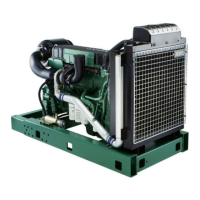24
Operation
Correct operation technique is very important for both fuel economy and engine life. Always let the engine warm
up to normal operating temperature before operating at full power. Avoid sudden throttle openings and operation at
high engine speeds.
Checking instruments
Check all instruments directly after starting, and then
regularly during operation.
IMPORTANT! On engines which operate continu-
ously, the lubrication oil level must be checked,
at least every 24 hours. Please refer to the
“Maintenance, lubrication system” chapter:
Fault indication
If the EMS 2 system receives abnormal signals from
the engine, the control unit generates fault codes and
alarms, in the form of lamps and audible warnings.
This is done by means of CAN signals to the instru-
ment.
More information about fault codes and fault tracing is
found in the “Diagnostic function” chapter.
Operation at low load
Avoid long-term operation at idle or at low load, since
this can lead to increased oil consumption and even-
tually to oil leakage from the exhaust manifold, since
oil will seep past the turbocharger seals and accompa-
ny the induction air into the inlet manifold at low turbo
boost pressure.
One consequence of this is that carbon builds up on
valves, piston crowns, exhaust ports and the exhaust
turbine.
At low load, the combustion temperature is so low that
full combustion of the fuel can not be ensured, which
means that the lubrication oil can be diluted by diesel
fuel, and the exhaust manifold will eventually leak oil.
If the following points are done as a complement
to normal maintenance, there will be no risk of
malfunctions caused by operation at low load.
• Reduce operation at low load to a minimum. If the
engine is regularly test run without load once a
week, operation duration should be limited to 5
minutes.
• Run the engine at full load for about 4 hours once
a year. Carbon deposits in the engine and exhaust
pipe can then be burned off.

